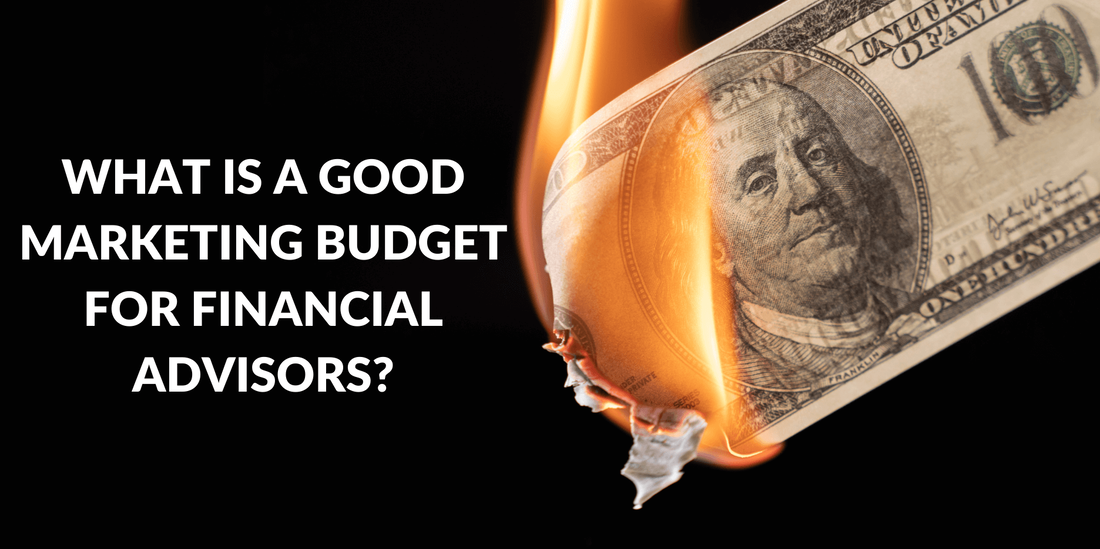What's A Good Financial Advisor Marketing Budget? Here's What I've Found, Backed By Research...By James Pollard, founder of TheAdvisorCoach.com and host of the "Financial Advisor Marketing" podcast. Connect with James on LinkedIn here.
Hey, financial advisors. Let's talk about budgeting.
I don't mean a household budget where you and your spouse quibble over the constant stream of Amazon packages piling up on your doorstep. I mean a marketing budget designed to get you more clients and grow your business. Since you're reading this article, you're interested in learning about marketing budgets. That's a great first step, but first, you must realize... Most Financial Advisors Don't Even Have Marketing Plans. 🤯A survey conducted for FA Insights by Design Study found that only 17% of financial advisors have developed strategic plans for their businesses.
Lol. What? This means 83% of financial advisors make plans for their clients without having planned for themselves. Ah, the irony. (By the way, if you’re interested in a simple, easy-to-follow marketing plan then I’ve created one here: Financial Advisor Marketing Plan.) As you create your marketing plan, you will wonder how much money you should allocate to marketing yourself, your services, and your business. You will likely think in terms of percentages. Various studies and surveys report that financial advisors typically spend 1 to 5% of their revenue on marketing. And I've seen coaches, gurus, consultants, and experts recommend spending anywhere from 1 to 10% of revenue. But I should warn you… That's Downright Reckless!Imagine if I told you that you should save 10% of your income.
Is that a good recommendation or a bad one? It's neither because it's meaningless without context. If you are drowning in debt and unable to pay your bills, you should get yourself on solid financial footing first. If you make $10 million per year and live a minimalist lifestyle, you will laugh at this advice as too easy. One of the biggest mistakes financial advisors make when building their businesses is that they stop thinking like financial advisors. Here's what I mean… When they're in front of clients, they think objectively, reason clearly, and articulate their strategies. But when it comes to marketing, those qualities go out the window. You should take the same thought process you use when working with clients and apply it to yourself and your business. Would you give people cookie-cutter advice without knowing them or their goals? I hope not. So, it's necessary to know YOUR business and YOUR goals before blindly following cookie-cutter marketing budget advice you find online. Here are three reasons why… Reason #1: Your Business Model Is Unique.Let’s say your revenue is a million dollars per year and you’re running a lifestyle business. As such, we’ll assume email marketing is the primary way you get new clients…
If you listen to the one-size-fits-all recommendation that your marketing budget should be 5% of your revenue, you will find yourself trying to spend $50,000. I’m sorry, but if you're paying anywhere NEAR $50,000 per year on email marketing, then you are doing it wrong. The most a good email marketing software should cost is a few hundred bucks per month. Plus, once in place, your email autoresponder sequence should run with no input from you. Spending 5% of your revenue would cause you to be wasteful. Conversely, let's examine the situation from the perspective of a new business, one that's just beginning to carve out its niche and hasn't yet established significant revenue streams. In such cases, adhering to a rigid 5% marketing budget may not be feasible or strategic. If the total revenue is low, 5% might not be enough to cover even the basic marketing initiatives required to gain traction and visibility in your market. This could stunt your business's growth, preventing it from reaching its full potential. The crux of the matter is that adopting a one-size-fits-all approach to your marketing budget can be detrimental, irrespective of whether you're at the helm of a well-established business or just starting out. Instead, a more nuanced approach is advisable. It's essential to evaluate the unique aspects of your business, including your industry, your target market, the stage of your business, and your specific growth objectives. By doing so, you can tailor your marketing budget to fit your unique needs, ensuring that every dollar spent contributes effectively towards reaching your business goals. Fixating on a one-size-fits-all budget is foolish in both scenarios. Reason #2: Your Cash Flow Is Unique.Different marketing strategies take varying amounts of time to work. For instance, SEO can take a long time. Social media can also take a long time. Email marketing, done the way I teach, can get appointments in a week or two.
Costs vary, too. Because even though it’s slow, social media marketing is “free.” And even though direct mail can get expensive, it can also set appointments for financial advisors in as little as a few days. The bottom line? Your cash flow will influence your marketing strategies. This is one reason why I tell financial advisors to avoid lifestyle creep. Because the financial advisor who makes $50,000 per month and spends all of it has no room to try new things. He is a slave to covering his monthly costs and cannot try new things to get him to the next level. On the other hand, the advisor who makes $20,000 per month and only lives on $5,000 per month can do $15,000 worth of tests and experiments… Every… Single… Month. Now, here is the million-dollar question… Who do you think is going to win the great game of business? The advisor hustling every month merely to pay his bloated lifestyle expenses... or the advisor running his business like a cool, collected blackjack player executing perfect strategy? Reason #3: Your Starting Point Is Unique.Remember, I want you to think like a financial advisor. Would you give the same advice to a 25-year-old with no children and a budding career as you would a retired 70-year-old with special needs children? Again, I hope not.
Your starting point will also dictate your marketing budget. For example, I talk a lot about building marketing assets on my Financial Advisor Marketing podcast. Because in the same way that wealthy people become wealthy by owning assets, successful financial advisors become successful by owning marketing assets. Marketing assets include…
And more. A financial advisor with a solid website, LinkedIn profile, and lead magnet can pour money into online ads and have them generate a far greater return on investment than a financial advisor with low-quality or nonexistent marketing assets. The advisor with marketing assets is further along in his journey and can spend more money on marketing. Next, let’s assume that for every $1 you spend on marketing, you get $2 back. Would you stay committed to an arbitrary percentage-of-revenue budget rule? You wouldn’t? Me neither. That’s why I believe… There Is No Such Thing As A Good Marketing Budget.Because marketing is either profitable or it isn't. If it makes money, you should continue spending until it doesn’t.
The only budget I think you should have is a test budget. You should be willing to spend a certain amount of money (depending on your preferences, cash flow, and starting point as discussed above) to see if something works. One of my biggest pet peeves with marketing budgets is that they presuppose you should spend a certain percentage no matter what. Well, what if a marketing strategy doesn’t work? Should you continue spending money on it to meet your budget? No way. (I’m looking at you, financial advisors who rent trade show booths every year. You KNOW they don’t work, yet you keep doing it. Stop.) Another reason why there is no such thing as a good marketing budget is because human beings tend to think linearly, even though marketing is rarely linear and is subject to the law of diminishing returns. Here’s an example of how linear thinking can harm you… Imagine you haven’t eaten anything all day, and a juicy steak gets your mouth watering. So, you devour a delicious 8-ounce ribeye. And it was such a wonderful experience that you eat a second one. But you discover that the second one is nowhere near as fulfilling as the first one because it comes with diminishing returns. This happens in marketing, too. Here are some examples…
What’s even scarier is that if diminishing returns don’t hurt you, saturation will. Because everything in excess reaches saturation. Let’s continue with that cold calling example. We’ll assume you can turn into a robot that can make flawless cold calls every hour of every day. Even in that scenario, you would have an upper limit of 24 hours per day. Plus… All Marketing Operates Based On Feedback Loops.Feedback loops aren’t linear, either.
The technical definition of feedback loops comes from systems theory. A feedback loop is when the outputs of a system affect its behaviors. There are two types of feedback loops: balancing and reinforcing. Balancing feedback loops tend toward equilibrium. Think of a thermostat. If you have your home's thermostat set to 72 degrees Fahrenheit and it is currently 68 degrees, your heater will activate and heat your home until it's 72. (Lots of financial advisors stay in their comfort zones due to these feedback loops. If a financial advisor is programmed to make $200,000 per year in personal income, then he will do whatever it takes to stay in that range. If it's December and he is only at $150,000, then he will push and strive to get to his comfort zone. Likewise, if it's December and he's already at $200,000, then he will coast for the rest of the year because of his internal balancing feedback loop.) Reinforcing feedback loops don’t counterchange like balancing feedback loops. Instead, they amplify change, resulting in exponential growth or decay. Tracking your metrics and applying what you learn can lead to an exponential growth feedback loop. Because if you test two things and find a winner, you can test against that winner, then test again, and so on. If you follow my “multiple marketing strategies” philosophy that I discuss in my Inner Circle newsletter, then you are mathematically guaranteed to experience exponential growth. Here’s why… The 80/20 rule dictates that 20% of your inputs generate 80% of your outputs. If you try five things, then you will, on average, discover one thing that generates 80% of your results. If you keep finding things that generate 80% of your results and combine them, you will get exponential growth, period. I don’t care who you are or how you feel about this. It is literally math applied to business, and it’s a reason why I’ve been able to garner so many success stories. There are also decaying feedback loops. For example, you might sleep poorly. So, you’re more likely to become irritable and stressed. Since you’re stressed, you lie awake in bed at night. This causes you to get less sleep, which makes the problem worse. Another thing I want you to take away from this article is that marketing budgets inhibit exponential growth feedback loops and accelerate decaying feedback loops. An arbitrary limit prevents you from putting the odds in your favor while simultaneously incentivizing wasteful spending. Seriously... Financial Advisor Marketing Budgets Are Dumb...When you slap a rigid cap on your marketing efforts, you’re basically tying one hand behind your back – you're boxing yourself in. Say you stumble upon a killer marketing channel that's turning every dollar you put in into five dollars out. If you’re stuck to a strict budget, you'll hit a wall. Instead of scaling up this golden goose, you're stuck watching potential revenue fly away because of some arbitrary spending cap. It’s like finding a winning lottery ticket and only cashing in part of it. Nonsense, right?
Now, I'm not saying to throw caution to the wind and spend like there's no tomorrow. But flexibility is key. If you're seeing positive returns, why stop? This isn't just about spending more; it's about spending smart. When something works, lean into it, analyze what’s making it tick, and feed that beast. Here’s a tip from the trenches: keep a slush fund, a set amount of cash reserved for testing new strategies beyond your successful ones. This is your laboratory, your sandbox for innovation. Because in the dynamic landscape of marketing, yesterday’s breakthroughs are today’s old news. Staying ahead means continually experimenting, learning, and adapting. And let’s tackle another big elephant in the room – fear. Fear of losing money can paralyze you. But remember, marketing isn’t a cost; it's an investment. Every dollar spent should be a seed planted for future growth. Sure, not every seed will sprout into a towering tree, but without planting them, you'll never know. So, shift your mindset: from fear of loss to excitement for potential gains. Finally, let's chat about the magic of compounding efforts. Just like compounding interest in the financial world, your marketing efforts can build upon themselves. A successful campaign not only brings in revenue but can also increase your brand's visibility, enhance your reputation, and even improve customer loyalty. These are the intangible benefits that aren’t immediately visible on a spreadsheet but are invaluable to long-term success. "Can't You Just Give Me A Number?"Okay, you win.
According to Broadridge’s third annual financial advisor marketing survey, advisors' average annual marketing spend is $16,090. However, only 15% of advisors report being very satisfied with their marketing return on investment. Since the financial services industry has been brainwashed into believing that marketing budgets should be a percentage of revenue, it doesn’t take a rocket scientist to see that this approach leads to dissatisfaction. To be fully transparent, I think a few high-spending financial advisors skewed that average high. Because another Broadridge study (Driving Client Acquisition) found that 43% of growth-focused financial advisors successfully onboarded 20+ clients per year, whereas only 16% of other advisors onboarded at this rate. They defined “growth-focused” as spending at least $5,000 per year on marketing. So, if you must have a number, then that’s it. At least $5,000 per year. Broadridge also found that only 26% of advisors reported having a defined marketing strategy. Yet, those with a defined marketing strategy onboarded twice as many clients over the last twelve months as those who didn’t. This point deserves to be hammered home: Broadridge's findings reveal a stark reality — only a quarter of advisors have a solid, documented marketing strategy. But here's the kicker: those who do are seeing double the client acquisition compared to their peers who fly by the seat of their pants. This isn't just a minor edge; it's a game-changing advantage. Let's drill down a bit more. Among advisors with a structured marketing plan, a whopping 57% reported winning new clients through social media efforts. This is huge when you contrast it with the mere 34% of advisors without a clear strategy seeing the same success. This gap isn't just about social media savvy; it’s about having a coherent plan that guides where to focus your energy, how to communicate your value, and who to target. But it's not just about posting on LinkedIn or tweeting a few times a week. A defined marketing strategy means understanding your audience inside and out — what are their pains, fears, dreams, and how can you meet them where they are? It's about crafting messages that resonate, choosing platforms where your prospects spend their time, and using metrics to refine your approach continuously. Imagine two advisors... One throws $20,000 at various marketing tactics like print ads, cold calls, and random social media posts without a cohesive plan. The other invests $5,000 but directs every dollar into targeted Facebook ads, LinkedIn engagement, and creating valuable content because they know that's where their ideal clients are. The first might get lucky and see some return, but the second is building a sustainable pipeline of leads that align with their ideal client profile. This is why the plea to ditch the traditional marketing budget is not about spending less or more — it’s about spending right. Arbitrary budget rules can lead you to pour money into strategies that aren't right for your business or your clients. They can trap you into a cycle of spending without evaluating effectiveness. Instead, start with strategy. Who are your ideal clients? What problems do you solve for them? Where can you find them? How can they find you? Answer these questions, and you'll have the foundation of a marketing plan that can guide your investments, track your returns, and grow your client base. The numbers speak for themselves. A random approach to marketing is like throwing darts blindfolded and hoping to hit the bullseye. A strategic approach is like turning on the lights, aiming carefully, and hitting the target again and again. So yes, please ditch the arbitrary marketing budget. Embrace a strategy that's tailored to your business, and then, thank me later. 👍🏻 About The Author...
Hey, I'm James Pollard. I'm the guy behind this website.
I've dedicated my career to empowering financial advisors to unlock their full potential. With a passion for marketing and a knack for cutting through the noise, I provide actionable strategies and insights that help financial advisors build better businesses. I'm also the host of the popular Financial Advisor Marketing podcast. Beyond the mic, I'm constantly sharing my expertise through The James Pollard Inner Circle™ newsletter, which has grown to become one of the most successful communities in the financial advice space. Thanks for stopping by and diving into my world. If you'd like to connect with me on LinkedIn, here is where you can find me. |


